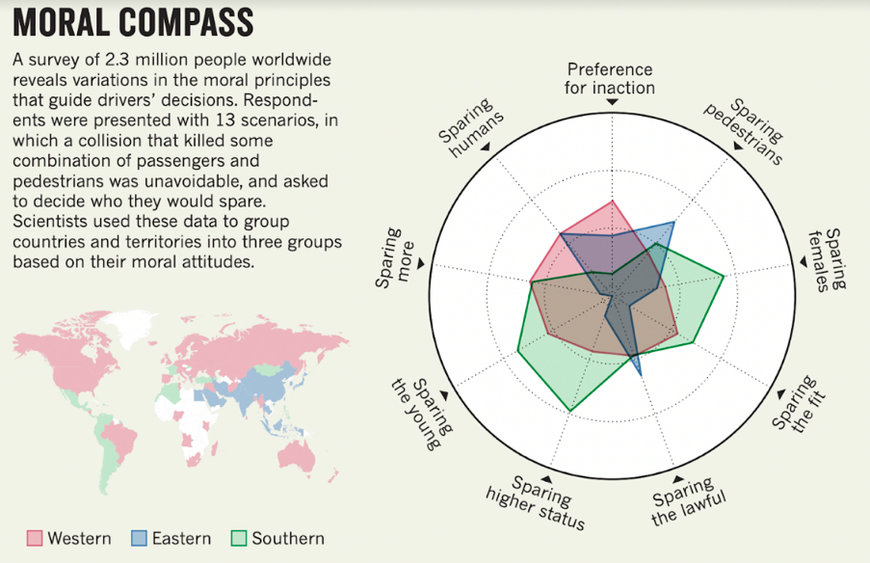Establishing an Ethical Framework for Autonomous Vehicles
By Mark Patrick, Mouser Electronics.

Moral compass prepared from a worldwide survey of 2.3 million people
What will this blog series cover?
- How self-driving technologies are redefining the automotive landscape
- Overcoming perceptions and embracing self-driving technologies
- Vehicle Autonomy: What are the key stages?
- Sensor Technologies for Autonomous Vehicles
- V2V and V2I delivers time-critical data for autonomous vehicles
- Establishing an Ethical Framework for Autonomous Vehicles
Driving can be a monotonous experience. Sometimes, we just get into the car and drive, with just a rough estimate of when we should arrive. However routine the driving might be, we still need to be alert and attentive throughout the journey, watching out for potential accidents, particularly during adverse weather conditions and in busy urban areas. We use our experience, gathered over the years, to decide what might lead to an accident, what situations to watch out for, and the actions we might need to take quickly.
As we’ve already covered in this blog series, sensing technologies provide the essential data for the vehicle’s autonomous systems to create a virtual real-time map of its surrounding environment. The map is further enhanced with information gathered from V2V and V2I communications. Armed with these vital information sources, autonomous machine-learning neural networks can navigate the journey safely, constantly watching out for and acting on potential dangers.
A self-driving vehicle is inherently more diligent and reliable than a human driver, who might become distracted or make an error of judgement. However, there are still situations where an accident might occur with fatalities likely. For the autonomous vehicle, making decisions based on life-or-death scenarios introduces moral and ethical challenges.
As we head towards fully autonomous vehicles on our roads, the ethical and moral dilemmas that autonomous systems will need to deal with are confronting the whole breadth of the automotive industry, from consumers, legislators, and insurance providers to vehicle manufacturers. There are some difficult decisions ahead, and these are likely to receive high visibility in the world’s press, which already appears eager to publish news about autonomous vehicle crashes.
Unfortunately, several fatalities have occurred with self-driving vehicles where, for example, the sensing algorithms have not inferred the potential of an impending accident or detected that another vehicle was passing dangerously close in front of it. Even with the sophisticated simulation techniques and extensive trials these systems undergo, the likelihood of a wild-card, random, unpredictable scenario happening is always present.
The Ethics of Life or Death
The decisions we make in situations where a fatality is unavoidable are extremely complex. There are split second decisions we make more on instinct than an in-depth analysis of the situation. How do we, as humans, let alone an autonomous vehicle, decide whether to swerve away from hitting a pedestrian and instead put multiple lives in jeopardy by hitting a pavement café. Would an autonomous system be programmed to recognise how many people are on a bus or in a cafe, for example? Attitudes towards which action humans might take also vary by region, as an article in Nature magazine on the moral compass dilemma highlighted.
The research project, conducted by a global team aimed to research and develop a set of global, socially acceptable principles for autonomous vehicles when faced with these moral and ethical situations. The regional variation in attitudes, if agreed at a national level, could be accommodated with fine-tuning neural network parameters.

City driving image
In Europe, the European Commission is working towards allowing fully autonomous vehicles on defined stretches of the European road network. In July 2022, the Vehicle General Safety Regulation stipulates a minimum statutory set of advanced driver assistance systems (ADAS) required on all road vehicles in addition to the technical requirements for Level 4 and Level 5 (see Blog 3: Vehicle Autonomy: What are the key stages?) fully autonomous vehicles. Within the EU, progress on tackling the thorny issue of ethics is fragmented, with nation states sometimes opting to push ahead by themselves.
An example is Germany, which has established an ethical code of conduct for autonomous vehicles in 2017. Prioritising human life and personal injury over that of animals or property becomes a key learning requirement for the machine learning algorithms faced with an unavoidable incident. The UK Government has yet to embrace the ethical debate, although it has issued guidance for conducting trials of self-driving vehicles on public roads within set criteria.
Who takes the blame?
Attributing responsibility for an accident becomes another interesting challenge. With human drivers, insurance companies, equipped with accident claims from the drivers involved together with reports from the emergency services, typically agree on who caused the accident. With fully autonomous vehicles, SAE Level 4 and Level 5, there is no driver nor any method of passenger intervention. In these cases, determining the cause of the accident may include the automotive manufacturer, the developer of the algorithms, sensor manufacturers, or, perhaps, a human driver in another vehicle.
A potential grey area might exist with Level 3, which stipulates a human driver needs to take over if the autonomous systems deem it necessary. Clearly, the nominated driver might have little time to react or be capable of doing anything to prevent an accident occurring.
Perhaps one advantage of investigating an accident involving an autonomous vehicle is the access to the vehicle’s ‘black-box’ data logs. In California, it is a legal requirement for autonomous test vehicles to provide a complete set of system data in the 30 seconds leading up to the crash. However, whether this requirement becomes the norm for every autonomous vehicle sold around the world is still uncertain.
Despite many challenges ahead, whether technical or moral, the goal of autonomous vehicles is to make our road safer for all road users, cut congestion, and reduce pollution. It’s only a matter of time before a socially acceptable moral framework can be implemented.
www.mouser.com

